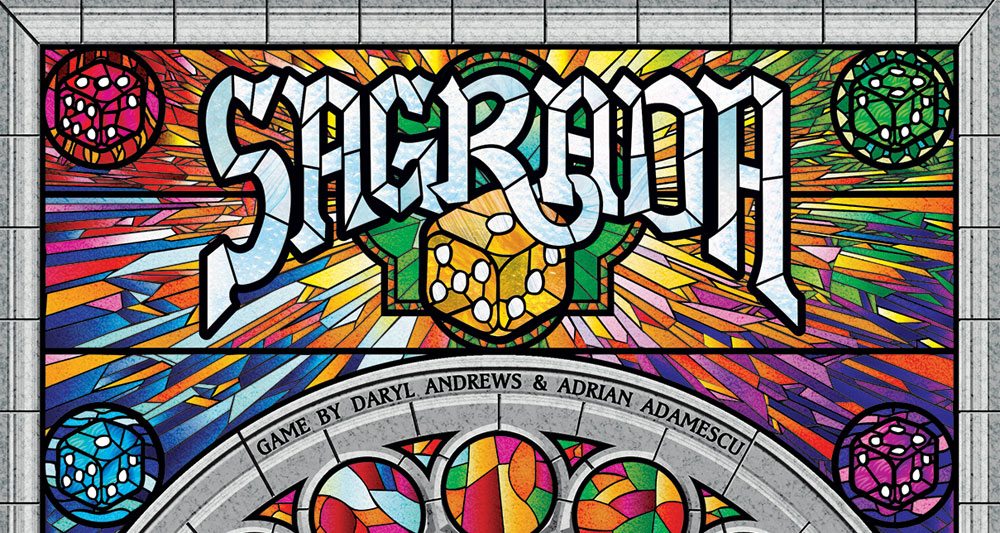The Basílica i Temple Expiatori de la Sagrada Família is a cathedral in Barcelona that was not yet completed when architect Antoni Gaudí died. Fortunately, you have his plans for the stained glass windows: in Sagrada, you and the other players compete to create the most beautiful windows for the cathedral.
At a glance: Sagrada is a dice-placement game, designed by Adrian Adamescu and Daryl Andrews, for 2 to 4 players, ages 14 and up, and takes about half an hour to play. It just launched on Kickstarter, with a pledge of $39 for a copy of the game. The theme is about building stained-glass windows, using colored dice on template cards. I think younger players would be able to handle it, maybe about 10 and up.
New to Kickstarter? Check out our crowdfunding primer.
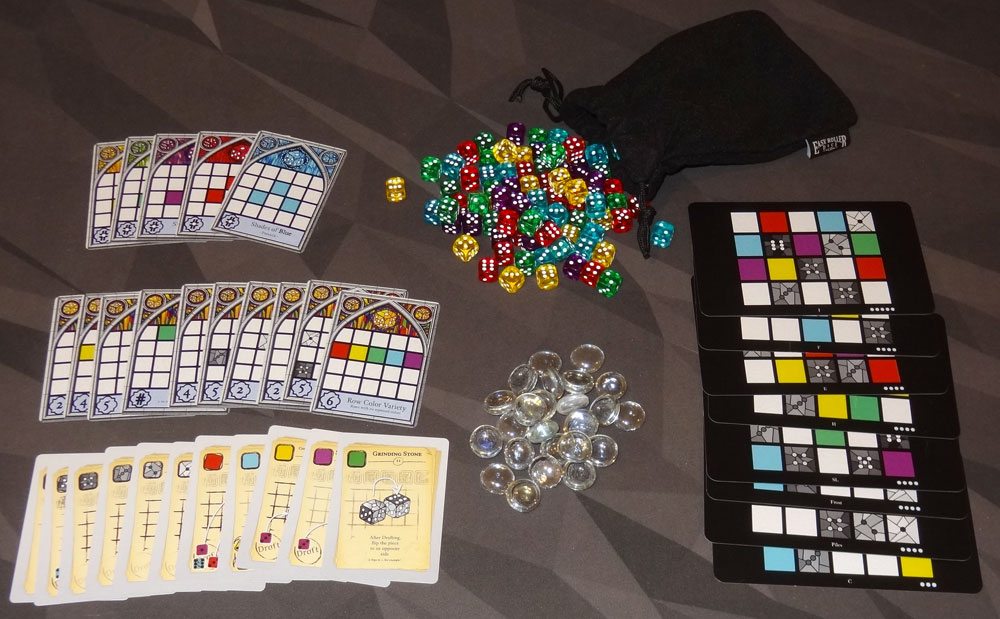
Components
Note: my review is based on a prototype, so the components pictured are not final. However, the artwork itself is final or near final, and the dice you see are the type that will be used in the game. For instance, my prototype did not have the round and scoring track, so we just kept track of that ourselves.
- 90 Dice in 5 colors
- 4 Player Boards
- 4 Windows Pattern Cards
- 10 Public Objective Cards
- 5 Private Objective Cards
- 10 Tool Cards
- Dice Bag
- 24 Favor Tokens
- Round & Scoring Track
The dice are 12mm transparent dice—so they’re a little smaller than the standard dice from most games, but the transparent colors really add to the stained-glass theme. The dice bag I have in the prototype is quite nice—flexible, unlike some of those stiff bags—so hopefully that’s the same type that will go in the final version.

The Windows Pattern Cards I have are just double-sided, with one pattern on each side, but my understanding is that the final version will have four patterns on each card (two per side), and then the player board looks like a stained-glass window on top, with a section at the bottom that lets one pattern show through and holds the dice in place. (See the above photo—the final board will have a stained-glass portion above the pattern.) Each pattern is a 4×5 grid, with some of the spaces showing either a color or a number, and others left blank.
The stained-glass artwork on the cards, by Peter Wocken, is lovely and really helps you get into the theme of the game. The tool cards are less pretty, just illustrating how each tool works.
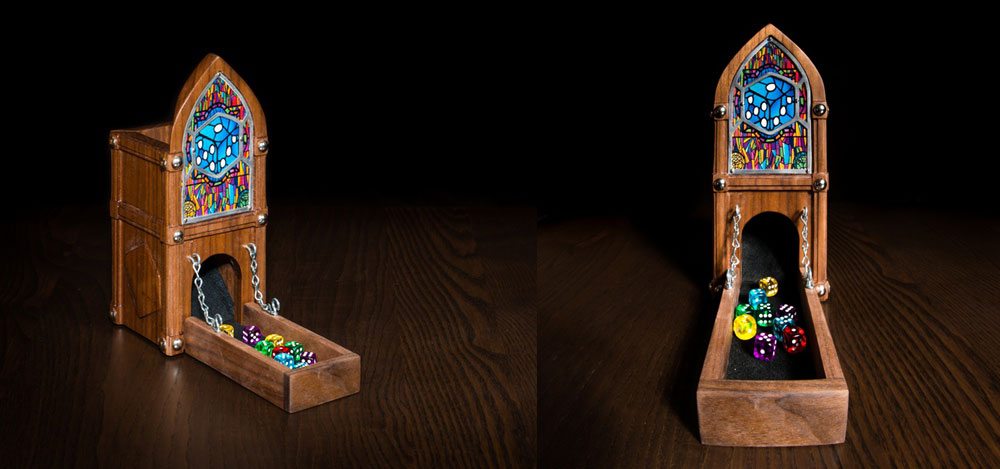
One of the add-on options for the Kickstarter is a custom dice tower from Dogmight, and it looks gorgeous. I mean, you don’t need a dice tower to play Sagrada, but if you like lovely gaming accessories, this one is hard to beat. If I had one of these, I would probably use it for all of my dice games regardless of theme, even Tiny Epic Galaxies.
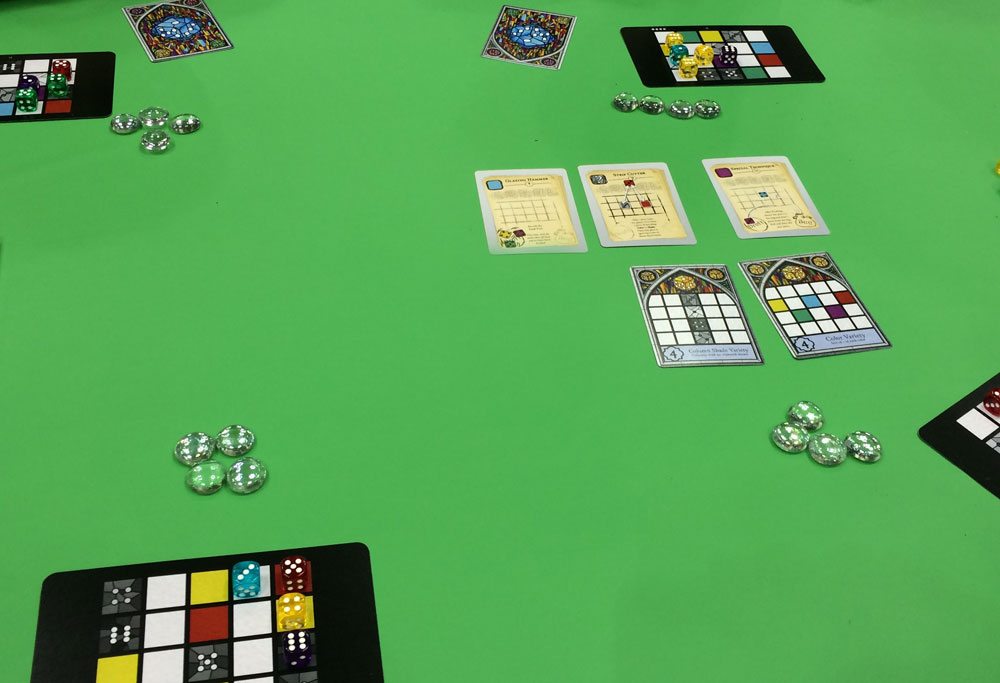
How to Play
The goal is to score the most points after 10 rounds of play, by fulfilling public and private objectives.
To set up, each player gets a windows pattern card and a player board. Each player chooses one of the 4 window patterns on the card, and slides the card into the player board so that window is visible, and then takes the number of favor tokens indicated on the pattern card. Put all the dice in the dice bag. Shuffle the tool cards and lay out 3 on the table. Shuffle the objective cards and place 2 public objectives on the table. Give each player a random private objective card. The start player takes the dice bag.
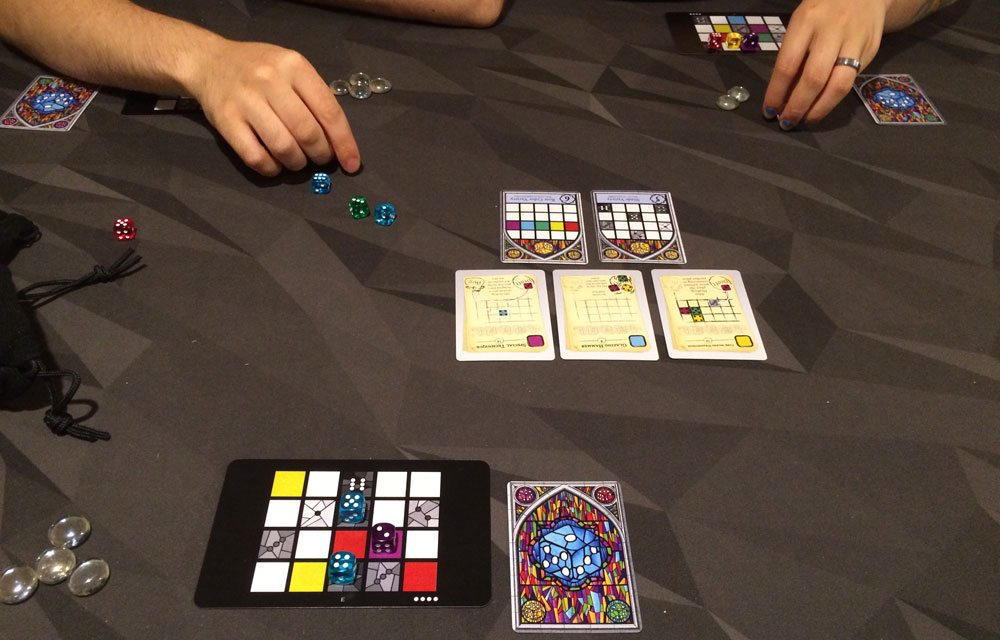
Each round, the start player will draw dice from the bag and roll them: the number is based on the number of players, because there will be enough for each player to take 2 dice, with one remaining. Each player will take a turn in turn order, and then each player will take a second turn in reverse order. On your turn, you may draft 1 die and place it on your window and/or use 1 tool (in any order).
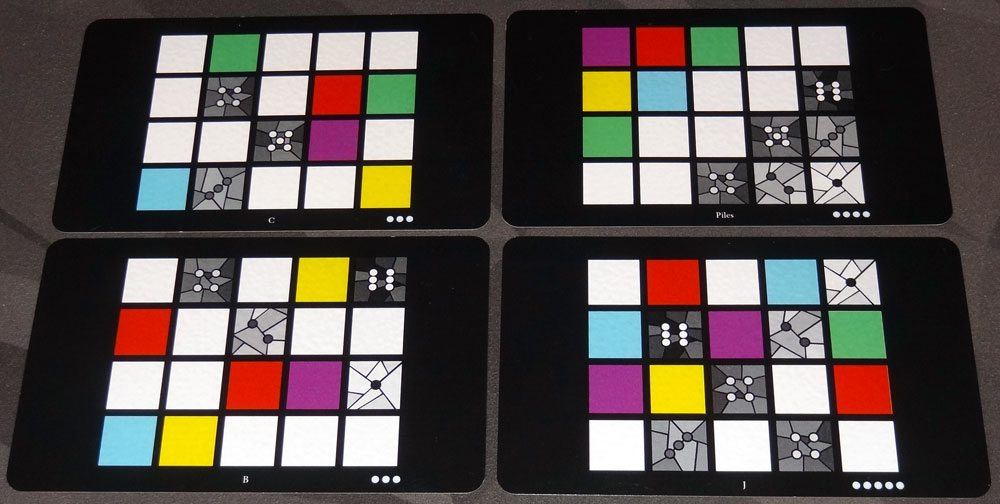
The first die you place on your window must be on an edge. All dice must match the requirements printed on the window card, if any—colors match colors, numbers (called “shades” in this game) must match numbers. After the first die, all subsequent dice must be adjacent (either orthogonally or diagonally) to an existing die. Also, you may never place a die orthogonally adjacent to another die of the same color or shade—that’s the part that is a little like Sudoku.
To use a tool, place favor tokens on the tool card to use its ability. If the tool card is empty (i.e., it hasn’t been used yet), you pay 1 favor token; if it already has tokens on it, it costs 2 tokens to use.
After each player has had two turns, any remaining dice are placed on the round track, and then the dice bag is passed to the next player.
At the end of 10 rounds, the game ends, and you score your windows.
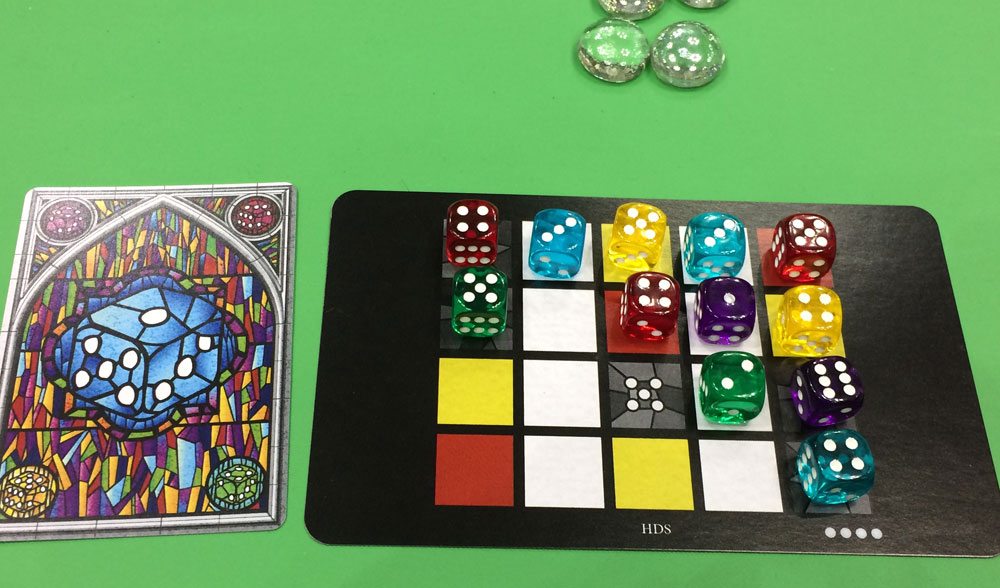
You get points for fulfilling the public objectives, which will award points for certain combinations. Private objectives will state a particular color: you get 1 point per pip for each die of that color. You add 1 point per favor token you have left, and then lose 1 point for each unfilled space on your window card.
The highest score wins: ties go to the most points from private objectives, then most favor tokens.
There are solo rules included as well: instead of favor tokens, you spend dice to use the tools (the die must match the tool card), but each tool may only be used once, and empty spaces are -3 points at the end of the game. The goal is to score more points than the total of the dice on the Round Track.
The Verdict
When I first saw the prototype of Sagrada at Gen Con, I liked it immediately. It’s beautiful to look at, but it also has a puzzle aspect that reminded me of Sudoku, though it’s not strictly the same thing. And while I love sci-fi and zombies and the wild west as much as anyone, it’s always refreshing to see a game with a seldom seen theme.
The gameplay is pretty easy to teach: draft dice, use special powers on the tools, get as many objectives as you can while matching your pattern. For the most part, everything “clicks” the first time you play it, so you can focus on your choices rather than trying to learn the rules. There were just a few things that players needed reminders of: for instance, the fact that tools cost 1 favor token at first but then go up to 2. And, as easy as it is to understand the “no identical colors or shades next to each other” rule, inevitably a player will look down and realize that they have two 3s next to each other halfway through the game. (For that, I’m told there will be some sort of standard penalty when discovered—something like removing and discarding dice until all placements are valid.)
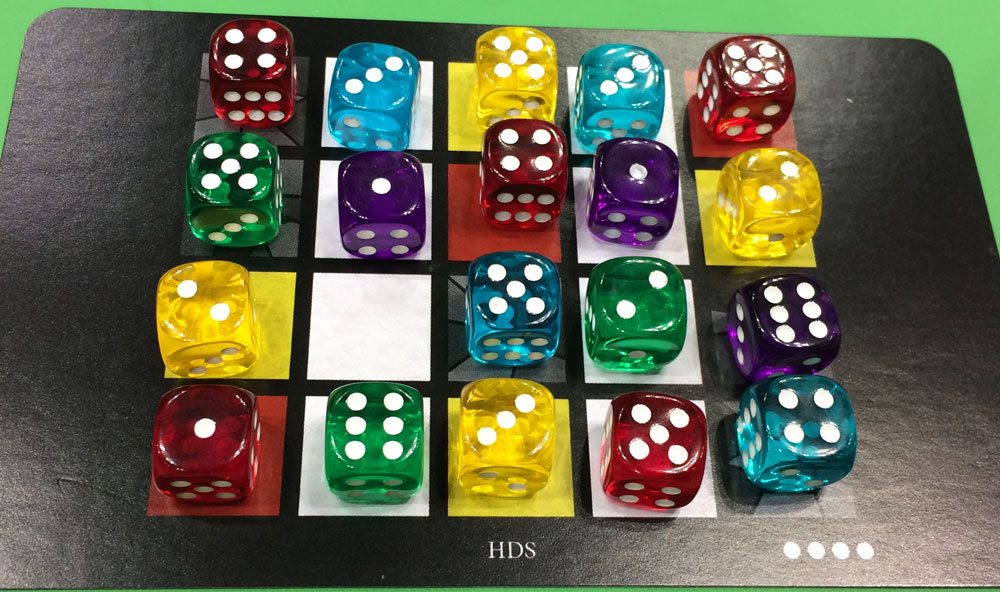
That Sudoku element of not placing similar dice next to each other seems like a really easy rule—after all, it’s just right next to each other, not in an entire row or column, as it would be in actual Sudoku. However, when placing dice you also have to take into account the requirements on your particular window pattern. It can be very easy to trap yourself: for instance, you have a spot that requires a 4, so you place a green 4 there … only to realize later that a space next to it requires green, and therefore can’t be filled. Or, you place dice around a space and realize you’ve severely limited what can go there: in the photo above, the only things that can fill the remaining hole are a red 3 or 4, because I put different colors and numbers surrounding it.

And then, of course, there are the objectives. The private objectives are all color-based: each player will have one of the five colors, and you try to just maximize all of the dice of that color for bonus points. The public objectives, however, require particular sets of dice: for instance, the “row/column variety” objectives give you bonuses for having no repeats across rows or columns. If that’s the case, you not only have to match your own pattern, but you’re trying to figure out if it’s possible not to repeat. Combining your private and public objectives with your window pattern to maximize your score makes for a really great puzzle.

The tool cards, named after glassworking tools, are most often used to fix things—like when you realize there are no dice left in the pool that will fit on your window. Some tools let you move dice around, manipulate dice, reroll dice in the pool, or even steal dice from the round track. However, using them is expensive—you’re spending 1 or 2 points per use, and you only have so many favor tokens to begin with, so you need to make them count. I like that you’ve got a way to get yourself out of a sticky situation, but that it’s not easy or cheap.
There isn’t a lot of direct player interaction in Sagrada—you’re all working on your own windows, and you don’t get to break or damage somebody else’s window. However, it is a drafting game: you’re all drawing from the same pool of dice. So that means there’s plenty of opportunity to take the die that another player has been waiting for, if you’re paying attention (and mean). I do like the fact that the turn order goes clockwise and then in reverse—it means that the last player will get to pick two dice in a row, and it balances out a little bit of the disadvantage of picking last.
Sagrada has a good bit of chance, of course: which patterns you get, which objectives and tools are dealt out, which colors are drawn, and which numbers are rolled each round. But with the drafting and the tools, there’s still room for strategy. After all, a master artist can make beauty out of whatever materials are at hand, right?
I think Sagrada is a lovely game, even in its prototype form, and I can’t wait to see how it looks totally finished. If you like Sudoku, or stained glass, or lots of dice, you should definitely check out the Kickstarter page.
